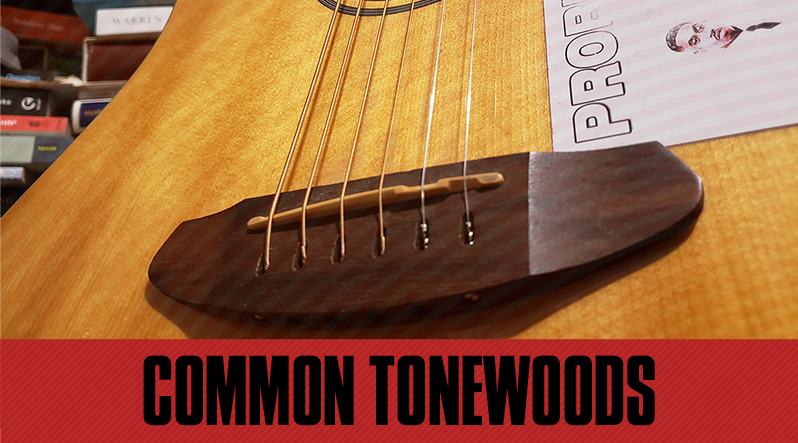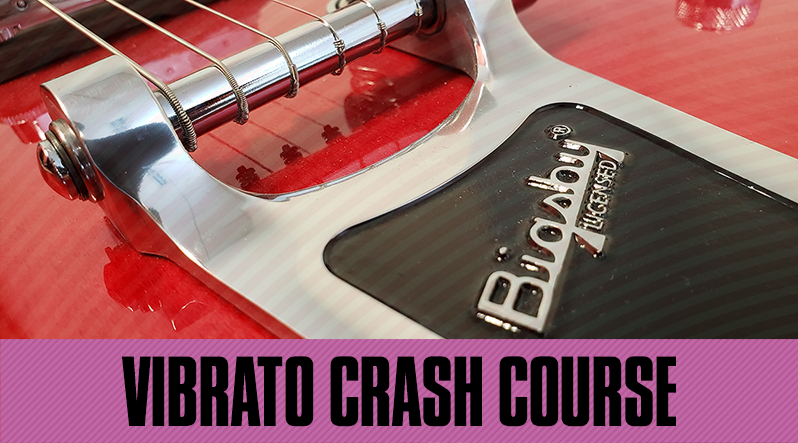
Wood is one of the most important factors in the sound of a guitar. The term "tonewood" refers to the particular wood used to build a guitar, many of which are known for having a particular tone. Most guitars employ a combination of tonewoods in order to achieve a certain sound, while others stick to one tonewood for the entire build. It all depends on what sound the luthier is trying to create.
For the purpose of this blog post, we'll focus on the main tonewoods used for building acoustic guitars. While we won't dive into all the different types of exotic tonewoods, these are the ones you're most likely to come across.
What do Tonewoods do?
When an acoustic guitar is strummed, the vibrations from the strings radiate from the bridge of the guitar to the very tip of the headstock. These vibrations shake the wood, and jump all around the sound hole, which then produces the beautiful tones we hear when we strum chords, or play individual notes.
Different woods will give the guitar different sound qualities. Some woods are more porous, or lighter, while others are heavier, or more dense. The tree that the wood comes from also contributes to variations in the wood as well. For example, if you use two blocks of wood, that were cut from the same tree, those two pieces of wood could potentially provide different tonal traits.
Before we get into the different types of wood, it’s important to make some quick notes on laminated woods. These types of woods are thin pieces of wood that are stuck together. They’re usually found in more affordable guitars. The alternative is solid wood, which are thicker pieces of wood that usually sounds a bit better since there are no extra materials or layers to interfere with the sound.
Tonewood for the Back and Sides
Acoustic guitars usually feature different woods just for the body. The wood used for an acoustic’s back and sides are usually not the same as the wood used for the top. Let’s take a look at some popular back and side woods.
Mahogany
This type of wood is supposed to give the guitar a rounded, and potentially warm sound, depending on the cut, but it’s also strong and sturdy. Mahogany is used in a lot of Gibsons, and other acoustics and electrics. Using this wood could make the guitar a little heavy as well.
Brazilian Rosewood
It’s probably the most popular tonewood since just about every guitar manufacturer uses this. The majority of guitars in the past have used Brazilian Rosewood, so much that the world’s reserve or this wood has depleted to the point that it's practically endangered according to the Convention on International Trade in Endangered Species of Flora and Fauna (CITES). It’s known for its dark colors, its highly resonant characteristics. Musicians and luthiers would say that this tonewood has the most balanced tone, and it’s certainly one of the most expensive since guitars with this wood are not mass-produced as much as they once were.
There’s also another version of Rosewood called Indian Rosewood and it’s very similar to the Brazilian except it’s a bit darker in color and may produce a thicker tone.
Sapele
This wood is very similar to mahogany and is also used as a top wood and a neck wood. The biggest difference between this and mahogany is that it may sound a little brighter, or the treble will be a bit more pronounced. Sapele is also a bit harder than mahogany which could impact the tonal qualities.
Koa
The Hawaiian tonewood! Koa is usually put into special edition guitars because it can be pricey. It’s known for its beautiful colors and bright sounding tone. Some builders love this wood for it’s balanced properties, fitting somewhere between the crispy sonic qualities of rosewood and the warm characteristics of mahogany. Some also say that koa ages and sounds better over time.
Tone wood for the Top
Spruce
This is by-far the most popular tonewood for the tops of acoustic guitars. Sometimes these woods are known as Stika Spruce, which is another variety of the wood. Overall, spruce is used as the top of an acoustic because it has a very nice balance to the tone. There’s not much else to say about this one. It’s always a solid choice (pun intended).
Cedar
Fingerstyle guitar players usually end up with guitars that have this wood because of its tonal qualities. This wood is not as dense as spruce and that can lead to cedar-topped guitars as sounding a little quieter. But the payoff is that this top wood is great if you’re looking for a warmer tone. A number of classical guitars use cedar as a top.
Maple
This tonewood is also often used as a top for guitars, though it may be more common to use this wood as back and sides. The maple wood provides superior clarity as a top with a pale and light color. This wood is pretty dense and it’s hard which means that there’s not a whole lot of room for vibrations and sound to resonate. But it makes up for this again, for its crystal clear tone. Every single note you pluck or chord you strum will cut through the noise.
Tonewood for the Neck
Rosewood
This is the same rosewood from earlier in this post. It’s super popular on fretboards because of all of the mentioned qualities above. It’s well-balanced in tone, and it’s also really hard. Since it’s a bit stronger, that means it can take quite a bit of a beating and still be okay. It also has a smooth feel to it, making it arguably the best tonewood for your fretboard.
Maple
This wood is often used as fretboards and necks but it’s more commonly used on electrics. Sometimes they’re used on acoustics for their bright tone, and their lighter color.
Tonewoods are important when choosing a guitar you want to try or purchase. Some would say that they have a great impact on the guitar’s tone as well. But as fun and interesting as tonewoods are, it’s also important to note that the wood is one out of many factors that will give the guitar its sound. A guitar’s shape, strings, and if it’s electric, its pickups will also contribute to the overall tone.

